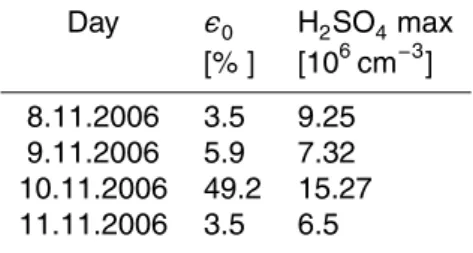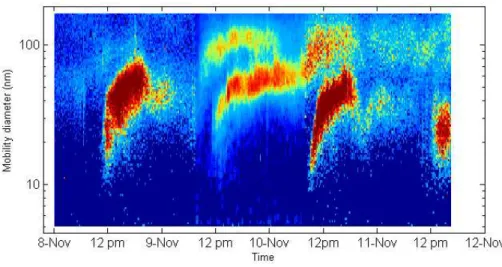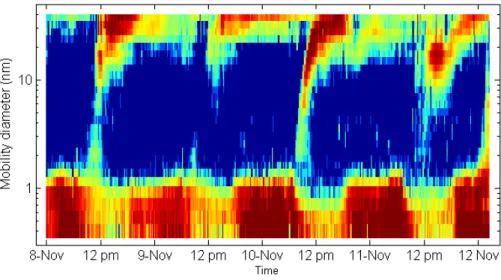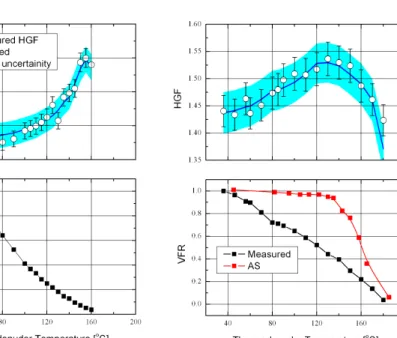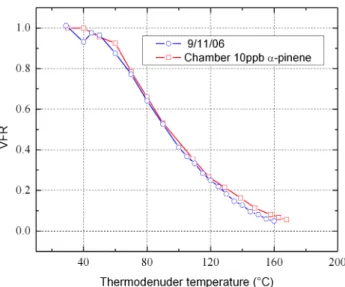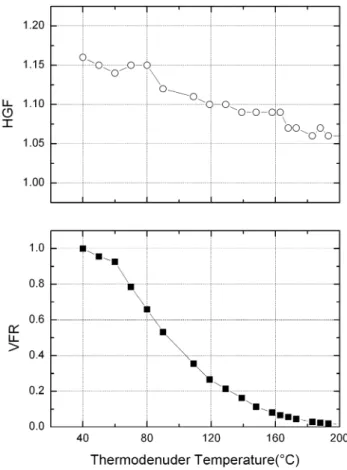ACPD
9, 17793–17815, 2009Sulphates and Organics in new particle formation
Z. D. Ristovski et al.
Title Page
Abstract Introduction
Conclusions References
Tables Figures
◭ ◮
◭ ◮
Back Close
Full Screen / Esc
Printer-friendly Version
Interactive Discussion Atmos. Chem. Phys. Discuss., 9, 17793–17815, 2009
www.atmos-chem-phys-discuss.net/9/17793/2009/ © Author(s) 2009. This work is distributed under the Creative Commons Attribution 3.0 License.
Atmospheric Chemistry and Physics Discussions
This discussion paper is/has been under review for the journalAtmospheric Chemistry and Physics (ACP). Please refer to the corresponding final paper inACPif available.
The role of sulphates and organic
vapours in new particle formation in a
eucalypt forest
Z. D. Ristovski1, T. Suni2, M. Kulmala2, M. Boy2, N. K. Meyer1,*, J. Duplissy3,**, A. Turnipseed4, L. Morawska1, and U. Baltensperger3
1
ILAQH, Queensland University of Technology, P.O. Box 4233, Brisbane QLD, 4001, Australia 2
Division of Atmospheric Sciences and Geophysics, Department of Physics, University of Helsinki, P.O. Box 64, 00014, Finland
3
Laboratory of Atmospheric Chemistry, Paul Scherrer Institut, 5232 Villigen, Switzerland 4
ANCAR/ACD, BAI Group, 3450 Mitchell Lane, Boulder, CO 80301, USA *
now at: Laboratory for Energy Systems Analysis, Paul Scherrer Institut, 5232 Villigen, Switzerland
**
now at: Physic Department, CERN, 1211, Switzerland
Received: 26 June 2009 – Accepted: 20 August 2009 – Published: 31 August 2009
Correspondence to: Z. D. Ristovski (z.ristovski@qut.edu.au)
ACPD
9, 17793–17815, 2009Sulphates and Organics in new particle formation
Z. D. Ristovski et al.
Title Page
Abstract Introduction
Conclusions References
Tables Figures
◭ ◮
◭ ◮
Back Close
Full Screen / Esc
Printer-friendly Version
Interactive Discussion
Abstract
The influence of biogenic particle formation on climate is a well recognized phe-nomenon. To understand the mechanisms underlying the biogenic particle formation, determining the chemical composition of the new particles and therefore the species that drive the particle production is of utmost importance. Due to the very small amount 5
of mass involved, indirect approaches are frequently used to infer the composition. We present here the results of such an indirect approach by simultaneously measuring volatile and hygroscopic properties of newly formed particles in a forest environment. We that the particles are composed of both sulphates and organics, with the amount of sulphate component strongly depending on the available gas-phase sulphuric acid, and 10
the organic components being photo-oxidation products of most likely a monoterpene. Our findings confirm a two-step process through nucleation and cluster formation fol-lowed by simultaneous growth by condensation of sulphates and organics that take the particles to climatically relevant sizes.
1 Introduction
15
The production of new aerosol particles from biogenic sources (forests, marine biota, etc) has been observed in a number of different environments (Kulmala et al., 2004). At regional scales, biogenic particle formation is a major source that determines the population of particles which seed droplet formation in clouds (cloud condensation nu-clei (CCN)) (Tunved et al., 2006). This way, they influence cloud properties and thereby 20
climate and the hydrological cycle (Kerminen et al., 2005). Determining the magnitude and drivers of biogenic aerosol production in different ecosystems is therefore crucial for the future development of climate models. Regardless of extensive research efforts, many aspects of biogenic particle production remain elusive. Most studies have been conducted in continental and coastal sites in the Northern Hemisphere (Kulmala et al., 25
ACPD
9, 17793–17815, 2009Sulphates and Organics in new particle formation
Z. D. Ristovski et al.
Title Page
Abstract Introduction
Conclusions References
Tables Figures
◭ ◮
◭ ◮
Back Close
Full Screen / Esc
Printer-friendly Version
Interactive Discussion and transformation processes have been performed for many years. A picture of the
main parameters influencing particle formation at this site is slowly emerging. The two major components of the freshly nucleated particles have been identified as sulphates and organics and their precursors are sulphuric acid and photo-oxidation products of volatile organic compounds (VOC’s), respectively. Although sulphuric acid has been 5
identified as one of the key components in aerosol formation and growth (Berndt et al., 2005; Riipinen et al., 2007), its exact role as well as the processes limiting new particle formation are still unclear. The presence of a large pool of neutral clusters has been recently experimentally observed (Kulmala et al., 2007b). It has been postu-lated that they are composed of ammonium bisulphate (Vehkamaki et al., 2004). The 10
question that remains is up to what sizes these sulphate clusters can grow and what factors influence their growth. Measurements of the water uptake (hygroscopic growth) of freshly nucleated particles in the same environment (Ehn et al., 2007) indicate a large soluble component, most likely sulphates, in particles smaller than 20 nm. Al-though it seems that sulphates are responsible for the initial formation of particles they 15
cannot explain their growth to observed sizes of over 50 nm (Boy et al., 2005). The vapours causing the condensational growth are low-vapour-pressure organic species whose exact chemical natures are unknown. Although there is relatively strong evi-dence that the growth rates and composition of larger than 50-nm particles are tied to the photo-oxidation of monoterpenes (Laaksonen et al., 2008; Tunved et al., 2006), 20
evidence for the presence of these organic vapours in freshly nucleated 3–10 nm par-ticles is scarce. This is mainly due to the lack of online analytical methods capable of assessing the composition of particles smaller than 30 nm in diameter. Until now, the main evidence has come from indirect methods that have measured the growth rates of newly formed particles when exposed to organic vapours (butanol (O’Dowd et al., 25
ACPD
9, 17793–17815, 2009Sulphates and Organics in new particle formation
Z. D. Ristovski et al.
Title Page
Abstract Introduction
Conclusions References
Tables Figures
◭ ◮
◭ ◮
Back Close
Full Screen / Esc
Printer-friendly Version
Interactive Discussion condensation particle counter battery (Kulmala et al., 2007a) where the composition of
particles as small as 3 nm can be inferred through their activation properties in different vapours, namely butanol and water. Applying this technique at a rural background site (Hyyti ¨al ¨a), the authors show that the freshly formed particles at 3 and 11 nm contain water-soluble material. They further show (Riipinen et al., 2009) that at the smallest 5
sizes (2–4 nm) the particles activate for growth at clearly smaller sizes in water than in butanol vapour, however less than would be expected from ammonium sulphate or sul-phuric acid. This indicates a presence of other less hygroscopic components in freshly nucleated particles.
The main problem in developing online experimental techniques for the characteriza-10
tion of the chemical composition of freshly nucleated particles is the very low mass of the sample. However, indirect methods exist that are capable of shedding light into the composition of these particles. For instance, measurements of particle hygroscopic properties and/or volatility are often used to infer the composition of even the small-est particles below 20 nm (Johnson et al., 2005). Here we utilize a recently developed 15
instrument, the Volatility and Hygroscopicity Tandem Differential Mobility Analyzer (VH-TDMA) (Johnson et al., 2004, 2008), that measures the volatility and hygroscopicity of particles simultaneously. The instrument selects a narrow particle size range from the ambient size distribution and heats the particles to a desired temperature. Any volatile material present in the particles will start to evaporate, which leads to a reduction in 20
particle diameter. Next, the particles are exposed to a controlled high humidity. If the particle diameter increases (as a result of hygroscopic growth) a hydrophilic component must be present. The process is repeated several times so that with slowly increas-ing temperature, more of the particle is evaporated. This way, the particle diameter slowly decreases, and at regular intervals we then measure the hygroscopic growth of 25
photo-ACPD
9, 17793–17815, 2009Sulphates and Organics in new particle formation
Z. D. Ristovski et al.
Title Page
Abstract Introduction
Conclusions References
Tables Figures
◭ ◮
◭ ◮
Back Close
Full Screen / Esc
Printer-friendly Version
Interactive Discussion oxidation products of a monoterpene, such asα-pinene. We also found the amount of
sulphates present in particles to be closely related to the concentration of SO2, and therefore to sulphuric acid concentration (Boy et al., 2006). Furthermore, our results add to the increasing amount of evidence that oxidised monoterpenes are crucial for the subsequent condensational growth of the particles to climatically relevant sizes. 5
2 Materials and methods
2.1 Field measurements
The data collected in this work were measured in November 2006 as part of a larger measurement campaign EUCAP (Eucalypt Forest Aerosols and Precursors) at the Tumbarumba flux station (35◦ 39′20.6′′S 148◦ 09′7.5′′E, 1200 m a.s.l.) in south
east-10
ern New South Wales, Australia. The Tumbarumba flux station is located in a tall open Eucalypt forest where the dominant species in this forest areE. Delegatensis (Alpine Ash) andE. dalrympleana(Mountain Gum) with average tree height of around 40 m. The instruments were located in a shed on the ground with the aerosol inlet at 2 m height. The size distribution of air ions was measured with an Air Ion Spectrometer 15
(AIS; Airel LTD, Estonia) (0.34 to 40 nm) and the size distribution of the sum of neu-tral and charged airborne particles with a Scanning Mobility Particle Sizer (SMPS, TSI 3936) (5 to 168 nm). The combined volatile and hygroscopic properties of the particles were measured with a VH-TDMA. Both the SMPS and the AIS sampled continuously during the whole campaign with a time interval of 6 and 5 min between two samples, 20
respectively. The AIS, capable of observing smaller particles (down to 0.34 nm) than the SMPS (5 nm in this study but usually down to 3 nm), is ideal for studying the initial steps of growth of new aerosol particles. In this study, the purpose of the AIS was to detect the new-particle formation events as early as possible so the VH-TDMA could be prepared for sampling the growing particles in time.
25
ACPD
9, 17793–17815, 2009Sulphates and Organics in new particle formation
Z. D. Ristovski et al.
Title Page
Abstract Introduction
Conclusions References
Tables Figures
◭ ◮
◭ ◮
Back Close
Full Screen / Esc
Printer-friendly Version
Interactive Discussion a relatively stable size of 20–30 nm, this mode was selected and analysed by the
VH-TDMA. The thermodenuder temperature was scanned from room temperature un-til the particles were completely volaun-tilized or reduced in size bellow the detection range of the VH-TDMA (7.5 nm). The maximum thermodenuder temperature neces-sary for complete volatilisation ranged from 150 to 180◦C, with a residence time of
5
around 2 s. The particle volatilisation is presented through the volume fraction remain-ing VFR=(Dv/Dv0)3, where Dv0 is the particle diameter at room temperature and Dv the particle diameter after heating in the thermodenuder to a temperature Td. The
change in the hygroscopic properties after volatilization is presented through the de-pendence of the hygroscopic growth factor HGF=Dh/Dv on the thermodenuder tem-10
perature, whereDh is the particle diameter after volatilisation and subsequent
humid-ification. For each thermodenuder temperature the VFR and the change in the HGF was measured. The relative humidity during temperature scans was kept constant at RH=90±0.2%. The error bars for the HGF on all figures are±2% and come from the
accuracy of particle sizing. SO2 was measured by pulsed laser fluorescence (Thermo 15
Environmental, Model 43C-TLE) from a height of 50 m. Sample air was drawn (13 Lpm) through a Teflon inlet line by a diaphragm pump. This flow was sub-sampled by the SO2 analyzer along with other trace gas analyzers. Other trace gases measured from this inlet included O3 (UV-absorption, Model 205, 2B Technology) and oxides of nitrogen (O3-induced chemiluminescence, Model 88Y, Ecophysics).
20
2.2 Chamber studies
Measurements of the volatile and hygroscopic properties of the photooxidation prod-ucts ofα-pinene were conducted in the smog chamber (Paulsen et al., 2005) at the Paul Scherrer Institute, Switzerland. Details of the experiments are presented in Meyer et al. (2009). The SOA was generated via photo-oxidation of α-pinene in a 27 m3 25
con-ACPD
9, 17793–17815, 2009Sulphates and Organics in new particle formation
Z. D. Ristovski et al.
Title Page
Abstract Introduction
Conclusions References
Tables Figures
◭ ◮
◭ ◮
Back Close
Full Screen / Esc
Printer-friendly Version
Interactive Discussion tinuously flushed into the chamber with pure air. Four xenon arc lamps were used
to simulate the solar light spectrum and initiate the photochemical reaction. The VH-TDMA measurements were conducted several hours since the lights were turned on and condensation of organic species was considered to have ceased.
3 Results and discussion
5
3.1 Observation of nucleation events
During the campaign, we observed new particle formation events almost on a daily ba-sis. Figure 1 shows the particle size distribution measured with an SMPS (5–168 nm) during the nucleation events, while Fig. 2 shows the size distribution of air ions from 0.34 to 40 nm measured on the same days with the Air Ion Spectrometer. The par-10
ticle formation events have started around noon and were preceded by relatively low particle concentrations. Especially strong nucleation events were observed on 8 and 10 November. It is interesting to observe that the highest SO2 concentration was ob-served for the 10 November. From the above ion and particle size distributions, ion and particle growth rates in the range from 7–20 nm were calculated and are presented in 15
Table 1. In addition the formation rate is also shown.
3.1.1 VH-TDMA measurements
Once the new particles had grown to a diameter of about 25 nm, we simultaneously measured their volatility and hygroscopicity as a function of the heating temperature (Td) with the VH-TDMA. Figure 3a and b present the results for 9 and 10 November,
20
ACPD
9, 17793–17815, 2009Sulphates and Organics in new particle formation
Z. D. Ristovski et al.
Title Page
Abstract Introduction
Conclusions References
Tables Figures
◭ ◮
◭ ◮
Back Close
Full Screen / Esc
Printer-friendly Version
Interactive Discussion while the second is less volatile but more hygroscopic. With increasing thermodenuder
temperature, more and more of the first component evaporates leaving the more hy-groscopic component within the particle. This results in further increase in the HGF.
However, the question remains, what are these two components? Organic com-pounds with low vapour pressure produced by photo-oxidation of monoterpenes are 5
likely candidates for the first component. Indeed, in environments where monoterpenes are abundant, they have been identified as a major component of particle mass (Cav-alli et al., 2006). They have relatively low HGF (Varutbangkul et al., 2006; Duplissy et al., 2008) and are volatile (Meyer et al., 2009). As further evidence that the first com-ponent is the product of photo-oxidation of a monoterpene such as α-pinene, Fig. 4 10
presents the volatilization of particles from a nucleation event observed on 9 Novem-ber and from a photochemical chamNovem-ber experiment with initialα-pinene concentration of 10 ppb (Meyer et al., 2009). These two curves show an excellent agreement which indicates that the more volatile but less hygroscopic particle component observed in the field measurements is of organic origin and the product of photo-oxidation of either 15
α-pinene or some similar monoterpene.
We postulate that the second, more hygroscopic component is of a sulphate nature. Evidence for this comes from the distinct difference in both volatilisation and hygro-scopic growth for the nucleation event observed on 10 November compared to those on 9 November. During this event, the observed HGF was significantly higher at room 20
temperature than during the event on 9 November. The reason for this relates to the role that sulphates play in the new particle formation events. The maximum measured SO2concentration on 9 November did not exceed 200 pptv whereas on 10 November it reached approximately 800 pptv. From the condensational sink formed by pre-existing aerosol and from the concentrations of SO2, VOCs, CO, NOx, and O3one can calculate 25
ACPD
9, 17793–17815, 2009Sulphates and Organics in new particle formation
Z. D. Ristovski et al.
Title Page
Abstract Introduction
Conclusions References
Tables Figures
◭ ◮
◭ ◮
Back Close
Full Screen / Esc
Printer-friendly Version
Interactive Discussion and the estimations for some not measured parameters, such as the RO2-radicals, an
average uncertainty of 50% would be realistic. The concentration of sulphuric acid on 10 November was 15.3×106cm−3, more than twice as high as the concentration on
9 November which was 7.3×106cm−3. This increased concentration of sulphuric acid
had led to a larger amount of sulphates present within the particles and, consequently, 5
to the higher observed HGF.
A further question is whether the sulphate component was sulphuric acid or some other more neutralised form such as ammonium sulphate or bisulphate. Sulphuric acid is rather volatile and will start to evaporate from the particles at temperatures below 100◦C. Since it is more hygroscopic than the photo-oxidation products ofα-pinene, we 10
should observe a reduction in HGF when it starts to evaporate, as we would be evap-orating a more hygroscopic component. This should occur at thermodenuder temper-atures above 100◦C, however, contrary to this, our measurements showed an increase in HGF up to 140◦C excluding sulphuric acid as the second component. Therefore,
we postulate that the more hygroscopic component responsible for the initial particle 15
growth was either ammonium sulphate or ammonium bisulphate, but not sulphuric acid. Both have similar HGF’s and volatilisation curves as measured by our VH-TDMA (John-son et al., 2004). This observation further points out to ammonium bisulphate as one of the candidates for neutral cluster formation in the atmosphere and its involvement in initial particle formation (Kulmala et al., 2007b).
20
Assuming that the two components are photo-oxidation products of organics (α-pinene) and ammonium sulphate, we fitted the measured HGF’s to a theoretical model (see Appendix A). The only fitting parameter within the model isǫ0, the initial volume
fraction of sulphates within the particle. The fitted curves using the ZSR prediction are presented as full blue lines on Fig. 3 (top graphs) for the nucleation event observed on 25
ACPD
9, 17793–17815, 2009Sulphates and Organics in new particle formation
Z. D. Ristovski et al.
Title Page
Abstract Introduction
Conclusions References
Tables Figures
◭ ◮
◭ ◮
Back Close
Full Screen / Esc
Printer-friendly Version
Interactive Discussion in Table 2 together with the calculated maximum concentrations of H2SO4molecules.
The fitted curves are in good agreement with the experimental results. On 10 Novem-ber (high SO2concentration)ǫ0was as high as 50% whereas on the 9th of November it was around 6%. Analyses of other events with similar concentrations of SO2 as on 9 November led to similar values ofǫ0. At high thermodenuder temperatures (130◦C
5
and 150◦C for the 10 and 9 November, respectively) the particles had reduced in size to 20 and 10 nm. Most of the organic component had evaporated and the particles consisted mainly of the sulphate component. A further increase in temperature led to the evaporation of the sulphate and the decrease of the measured HGF according to the Kelvin effect. This effect was more pronounced on 10 November as the sulphate 10
fraction was much larger.
4 Conclusions
These results clearly show that the sulphate component present in the particles is not sulphuric acid but a more neutralized form, either ammonium sulphate or bisul-phate. Our calculations further show that sulphates in most cases are responsible for 15
a reasonably small fraction (<6%) of the growth (see Table 2) with the organics being responsible for the remaining fraction. The only exception was the day with very high SO2concentration where the sulphates were responsible for almost 50% of the growth. We further observed a particle growth rate, in the 7–20 nm range, that was almost in-dependent of size (see Table 1). Thus our results actually confirm the existence of a 20
two-step process suggested by Kulmala et al. (2000, 2007b) with nucleation and clus-ter formation and subsequent growth of these particles being carried out not only by one component but by simultaneous growth of sulphates and organics.
As the sulphates compromise only a small fraction of the total particle volume whether the particles will grow to climatically relevant sizes will depend on the available 25
ACPD
9, 17793–17815, 2009Sulphates and Organics in new particle formation
Z. D. Ristovski et al.
Title Page
Abstract Introduction
Conclusions References
Tables Figures
◭ ◮
◭ ◮
Back Close
Full Screen / Esc
Printer-friendly Version
Interactive Discussion extended to other biogenic aerosol systems such as both coastal and remote marine
environments. Indeed, photo-oxidation products of other secondary organic aerosol precursors, such as isoprene produced by phytoplankton, have been proposed as ma-jor contributors to the change in the size distribution of CCN in the Southern Ocean (Meskhidze and Nenes, 2006). Biogenic atmospheric particle formation is a global 5
phenomenon and as such the observed role of sulphates together with organic vapours should be included in global climate models.
Appendix A
For particles that consist of several components the HGF of such mixed particle (HGFm) can be estimated from the growth factors of the individual components of the 10
particle and their respective volume fractions, applying the ZSR relation (Stokes and Robinson, 1966):
HGFm= X
k
ǫkHGF3k !1/3
(A1)
where the summation is performed over all of the compounds that are present in the particle. ǫk is the volume fraction and HGFk is the hygroscopic growth factor of each
15
of the components present in the particle.
The above simplified approach compared to full thermodynamic models is valid if there are no solute-solute interactions, i.e. that the water uptake of the mixed particle is equal to the sum of the individual water uptakes of each component. Correct treatment of the Kelvin effect within the ZSR relationship means to take the HGFk at equal water 20
ACPD
9, 17793–17815, 2009Sulphates and Organics in new particle formation
Z. D. Ristovski et al.
Title Page
Abstract Introduction
Conclusions References
Tables Figures
◭ ◮
◭ ◮
Back Close
Full Screen / Esc
Printer-friendly Version
Interactive Discussion Applying the ZSR relationship the HGFmof such a mixed particle becomes:
HGFm=(1−ǫAS) HGF3SOA+ǫASHGF3AS
1/3
(A2) whereǫASis the volume fraction of ammonium sulphate; HGFSOA and HGFASare the
hygroscopic growth factors of pure SOA and ammonium sulphate respectively. HGFAS is taken from ADDEM (Topping et al., 2005), whereas HGFSOAis taken from the cham-5
ber measurements (see Fig. A1). It should be noted that HGFSOA decreases slightly with increasing thermodenuder temperature. This temperature dependence was ap-proximated with a polynomial expression and used during the fitting procedure. Fur-ther the measurements of pure SOA were not available at the equal dry size. For this reason the semi-empirical k-Kohler theory (Petters and Kreidenweis, 2007) was used 10
to extrapolate the original measurement to the dry size required as input for the ZSR model.
For each thermodenuder temperature we have calculated HGFm from Eq. (A2). Us-ing the measured value of V F R (as shown on Fig. 3) we have calculated ǫAS. ǫAS increases with the increasing thermodenuder temperature as more SOA evaporates. 15
ThereforeǫAS at thermodenuder temperatureTd is calculated as:
ǫAS =VAS
V =
VAS V0
V0 V =
ǫ0
VFR (A3)
where: VAS is the volume of ammonium sulphate within the particle of volume V at
thermodenuder temperatureTd;V0 is the initial volume of the particle (before heating
in the thermodenuder) andǫ0=VAS
V0 being the volume fraction of ammonium sulphate at
20
room temperature (the initial volume fraction of ammonium sulphate).
Once the particle has evaporated to a diameter such thatǫAS becomes equal to 1
(the particle consists only of ammonium sulphate)ǫAS, used in Eq. (A2), was assumed to be constant and equal to 1. The only variable parameter for the fitting procedure wasǫ0.
ACPD
9, 17793–17815, 2009Sulphates and Organics in new particle formation
Z. D. Ristovski et al.
Title Page
Abstract Introduction
Conclusions References
Tables Figures
◭ ◮
◭ ◮
Back Close
Full Screen / Esc
Printer-friendly Version
Interactive Discussion Acknowledgements. The smog chamber measurements were supported by the European
Sci-ence Foundation (ESF) within the Interdisciplinary Troposphere Research: from the Laboratory to Global Change (INTROP, Exchange grant 1182). We also acknowledge funding from the Eu-ropean Network of Excellence ACCENT, EuEu-ropean Integrated project on Aerosol Cloud Climate and Air Quality Interactions (EUCAARI), Academy of Finland, Maj and Tor Nessling Foundation, 5
and the Centennial Foundation of Helsingin Sanomat.
References
Berndt, T., Boge, O., Stratmann, F., Heintzenberg, J., and Kulmala, M.: Rapid formation of sulfuric acid particles at near-atmospheric conditions, Science, 307, 698–700, 2005. 17795 Boy, M., Kulmala, M., Ruuskanen, T. M., Pihlatie, M., Reissell, A., Aalto, P. P., Keronen, P., Dal 10
Maso, M., Hellen, H., Hakola, H., Jansson, R., Hanke, M., and Arnold, F.: Sulphuric acid closure and contribution to nucleation mode particle growth, Atmos. Chem. Phys., 5, 863– 878, 2005,
http://www.atmos-chem-phys.net/5/863/2005/. 17795, 17800
Boy, M., Hellmuth, O., Korhonen, H., Nilsson, E. D., ReVelle, D., Turnipseed, A., Arnold, F., 15
and Kulmala, M.: MALTE – model to predict new aerosol formation in the lower troposphere, Atmos. Chem. Phys., 6, 4499–4517, 2006,
http://www.atmos-chem-phys.net/6/4499/2006/. 17797
Cavalli, F., Facchini, M. C., Decesari, S., Emblico, L., Mircea, M., Jensen, N. R., and Fuzzi, S.: Size-segregated aerosol chemical composition at a boreal site in southern Finland, during 20
the QUEST project, Atmos. Chem. Phys., 6, 993–1002, 2006, http://www.atmos-chem-phys.net/6/993/2006/.
Duplissy, J., Gysel, M., Alfarra, M. R., Dommen, J., Metzger, A., Prevot, A. S. H., Wein-gartner, E., Laaksonen, A., Raatikainen, T., Good, N., Turner, S. F., McFiggans, G., and Baltensperger, U.: Cloud forming potential of secondary organic aerosol under near atmo-25
spheric conditions, Geophys. Res. Lett., 35, L03818, doi:10.1029/2007GL031075., 2008. 17800
ACPD
9, 17793–17815, 2009Sulphates and Organics in new particle formation
Z. D. Ristovski et al.
Title Page
Abstract Introduction
Conclusions References
Tables Figures
◭ ◮
◭ ◮
Back Close
Full Screen / Esc
Printer-friendly Version
Interactive Discussion solubility and the influence of sulfuric acid, Atmos. Chem. Phys., 7, 211–222, 2007,
http://www.atmos-chem-phys.net/7/211/2007/. 17795
Johnson, G. R., Ristovski, Z., and Morawska, L.: Method for measuring the hygroscopic be-haviour of lower volatility fractions in an internally mixed aerosol, J. Aerosol Sci., 35, 443– 455, 2004. 17796, 17801
5
Johnson, G. R., Ristovski, Z. D., D’Anna, B., and Morawska, L.: Hygroscopic behavior of partially volatilized coastal marine aerosols using the volatilization and humidification tandem differential mobility analyzer technique, J. Geophys. Res.-Atmos., 110, D20203, doi:10.1029/2004JD005657, 2005. 17796
Johnson, G. R., Fletcher, C., Meyer, N.M., Modini, R., and Ristovski, Z. D.: A robust, portable 10
H-TDMA for field use, J. Aerosol Sci., 39(10), 850–861, 2008. 17796
Kerminen, V.-M., Lihavainen, H., Komppula, M., Viisanen, Y., and Kulmala, M.: Direct observa-tional evidence linking atmospheric aerosol formation and cloud droplet activation, Geophys. Res. Lett., 32, L14803, doi:10.1029/2005GL023130., 2005. 17794
Kulmala, M., Pirjola, L., and Makela, J. M.: Stable sulphate clusters as a source of new atmo-15
spheric particles, Nature, 404, 66–69, 2000. 17802
Kulmala, M., Vehkamaki, H., Petaja, T., Dal Maso, M., Lauri, A., Kerminen, V. M., Birmili, W., and McMurry, P. H.: Formation and growth rates of ultrafine particles: A review of observations, J. Aerosol Sci., 35, 143–176, 2004. 17794
Kulmala, M., Mordas, G., Petaja, T., Gronholm, T., Aalto, P. P., Vehkamaki, H., Hienola, A. I., 20
Herrmann, E., Sipila, M., Riipinen, I., Manninen, H. E., Hameri, K., Stratmann, F., Bilde, M., Winkler, P. M., Birmili, W., and Wagner, P. E.: The condensation particle counter battery (CPCB): A new tool to investigate the activation properties of nanoparticles, J. Aerosol Sci., 38, 289–304, 2007a. 17796
Kulmala, M., Riipinen, I., Sipila, M., Manninen, H. E., Petaja, T., Junninen, H., Dal Maso, M., 25
Mordas, G., Mirme, A., Vana, M., Hirsikko, A., Laakso, L., Harrison, R. M., Hanson, I., Leung, C., Lehtinen, K. E. J., and Kerminen, V. M.: Toward direct measurement of atmospheric nucleation, Science, 318, 82–92, 2007b. 17795, 17801, 17802
Laaksonen, A., Kulmala, M., O’Dowd, C. D., Joutsensaari, J., Vaattovaara, P., Mikkonen, S., Lehtinen, K. E. J., Sogacheva, L., Dal Maso, M., Aalto, P., Pet ¨aj ¨a, T., Sogachev, A., Yoon, Y. 30
ACPD
9, 17793–17815, 2009Sulphates and Organics in new particle formation
Z. D. Ristovski et al.
Title Page
Abstract Introduction
Conclusions References
Tables Figures
◭ ◮
◭ ◮
Back Close
Full Screen / Esc
Printer-friendly Version
Interactive Discussion products in continental new particle formation, Atmos. Chem. Phys., 8, 2657–2665, 2008,
http://www.atmos-chem-phys.net/8/2657/2008/. 17795
Meskhidze, N., and Nenes, A.: Phytoplankton and cloudiness in the southern ocean, Science, 314, 1419–1423, 2006. 17803
Meyer, N. K., Duplissy, J., Gysel, M., Metzger, A., Dommen, J., Weingartner, E., Alfarra, M. 5
R., Prevot, A. S. H., Fletcher, C., Good, N., McFiggans, G., Jonsson, ˚A. M., Hallquist, M., Baltensperger, U., and Ristovski, Z. D.: Analysis of the hygroscopic and volatile properties of ammonium sulphate seeded and unseeded SOA particles, Atmos. Chem. Phys., 9, 721– 732, 2009,
http://www.atmos-chem-phys.net/9/721/2009/. 17798, 17800, 17803 10
O’Dowd, C. D., Aalto, P., Hameri, K., Kulmala, M., and Hoffmann, T.: Atmospheric particles from organic vapours, Nature, 416, 497–498, 2002. 17795
Paulsen, D., Dommen, J., Kalberer, M., Prevot, A. S. H., Richter, R., Sax, M., Steinbacher, M., Weingartner, E., and Baltensperger, U.: Secondary organic aerosol formation by irradiation of 1,3,5 trimethylbenzene-NOx-H2O in a new reaction chamber for atmospheric chemistry 15
and physics, Environ. Sci. Technol., 39, 2668–2678, 2005. 17798
Petters, M. D. and Kreidenweis, S. M.: A single parameter representation of hygroscopic growth and cloud condensation nucleus activity, Atmos. Chem. Phys., 7, 1961–1971, 2007,
http://www.atmos-chem-phys.net/7/1961/2007/. 17804
Riipinen, I., Sihto, S.-L., Kulmala, M., Arnold, F., Dal Maso, M., Birmili, W., Saarnio, K., Teinil ¨a, 20
K., Kerminen, V.-M., Laaksonen, A., and Lehtinen, K. E. J.: Connections between atmo-spheric sulphuric acid and new particle formation during QUEST IIIIV campaigns in Heidel-berg and Hyyti ¨al ¨a, Atmos. Chem. Phys., 7, 1899–1914, 2007,
http://www.atmos-chem-phys.net/7/1899/2007/. 17795
Riipinen, I., Manninen, H. E., Yli-Juuti, T., Boy, M., Sipil ¨a, M., Ehn, M., Junninen, H., Pet ¨aj ¨a, 25
T., and Kulmala, M.: Applying the Condensation Particle Counter Battery (CPCB) to study the water-affinity of freshly-formed 2–9 nm particles in boreal forest, Atmos. Chem. Phys., 9, 3317–3330, 2009,
http://www.atmos-chem-phys.net/9/3317/2009/. 17796
Stokes, R. H. and Robinson, R. A.: Interactions in aqueous nonelectrolyte solutions: I. Solute-30
solvent equilibria, J. Phys. Chem., 70, 2126–2130, 1966. 17803
ACPD
9, 17793–17815, 2009Sulphates and Organics in new particle formation
Z. D. Ristovski et al.
Title Page
Abstract Introduction
Conclusions References
Tables Figures
◭ ◮
◭ ◮
Back Close
Full Screen / Esc
Printer-friendly Version
Interactive Discussion 1223–1242, 2005,
http://www.atmos-chem-phys.net/5/1223/2005/. 17804
Tunved, P., Hanson, H. C., Kerminen, V. M., Strom, J., Dal Maso, M., Lihavainen, H., Viisanen, Y., Aalto, P., Komppula, M., and Kulmala, M.: High natural aerosol loading over boreal forests, Science, 312, 261–263, 2006. 17794, 17795
5
Varutbangkul, V., Brechtel, F. J., Bahreini, R., Ng, N. L., Keywood, M. D., Kroll, J. H., Flagan, R. C., Seinfeld, J. H., Lee, A., and Goldstein, A. H.: Hygroscopicity of secondary organic aerosols formed by oxidation of cycloalkenes, monoterpenes, sesquiterpenes, and related compounds, Atmos. Chem. Phys., 6, 2367–2388, 2006,
http://www.atmos-chem-phys.net/6/2367/2006/. 17800 10
ACPD
9, 17793–17815, 2009Sulphates and Organics in new particle formation
Z. D. Ristovski et al.
Title Page
Abstract Introduction
Conclusions References
Tables Figures
◭ ◮
◭ ◮
Back Close
Full Screen / Esc
Printer-friendly Version
Interactive Discussion
Table 1. Ion and particle growth rates.
Day Growth rate (ions) Formation rate J2 between 7–20 nm [nmh−1] (ions) [cm−3s−1]
8.11.2006 9.06 0.26
9.11.2006 8.49 0.055
10.11.2006 6.48 0.23
ACPD
9, 17793–17815, 2009Sulphates and Organics in new particle formation
Z. D. Ristovski et al.
Title Page
Abstract Introduction
Conclusions References
Tables Figures
◭ ◮
◭ ◮
Back Close
Full Screen / Esc
Printer-friendly Version
Interactive Discussion
Table 2. Fitted values of the initial volume fraction of ammonium sulphate (ǫ0) for the 4 nucleation events analysed and the maximum calculated value of H2SO4concentration during the nucleation events.
Day ǫ0 H2SO4max [% ] [106cm−3]
ACPD
9, 17793–17815, 2009Sulphates and Organics in new particle formation
Z. D. Ristovski et al.
Title Page
Abstract Introduction
Conclusions References
Tables Figures
◭ ◮
◭ ◮
Back Close
Full Screen / Esc
Printer-friendly Version
Interactive Discussion
ACPD
9, 17793–17815, 2009Sulphates and Organics in new particle formation
Z. D. Ristovski et al.
Title Page
Abstract Introduction
Conclusions References
Tables Figures
◭ ◮
◭ ◮
Back Close
Full Screen / Esc
Printer-friendly Version
Interactive Discussion
ACPD
9, 17793–17815, 2009Sulphates and Organics in new particle formation
Z. D. Ristovski et al.
Title Page
Abstract Introduction
Conclusions References
Tables Figures
◭ ◮
◭ ◮
Back Close
Full Screen / Esc
Printer-friendly Version
Interactive Discussion
ACPD
9, 17793–17815, 2009Sulphates and Organics in new particle formation
Z. D. Ristovski et al.
Title Page
Abstract Introduction
Conclusions References
Tables Figures
◭ ◮
◭ ◮
Back Close
Full Screen / Esc
Printer-friendly Version
Interactive Discussion
ACPD
9, 17793–17815, 2009Sulphates and Organics in new particle formation
Z. D. Ristovski et al.
Title Page
Abstract Introduction
Conclusions References
Tables Figures
◭ ◮
◭ ◮
Back Close
Full Screen / Esc
Printer-friendly Version
Interactive Discussion

